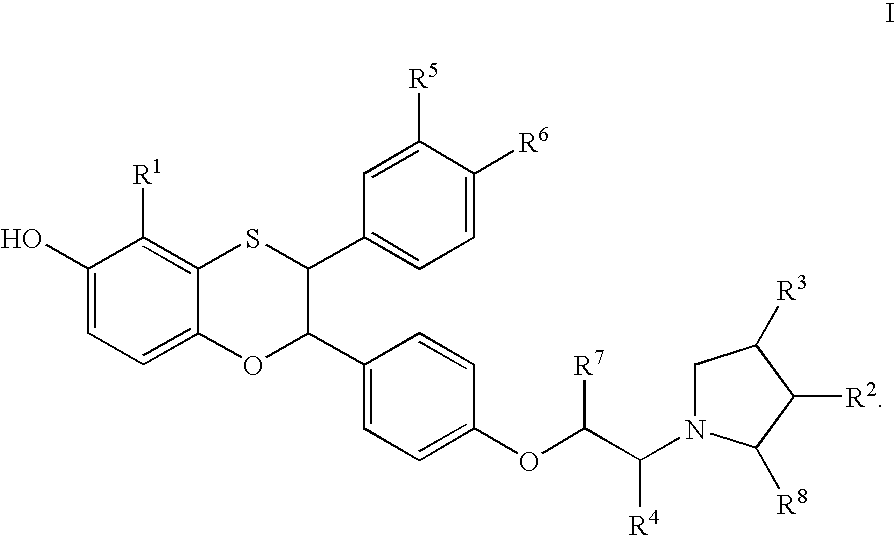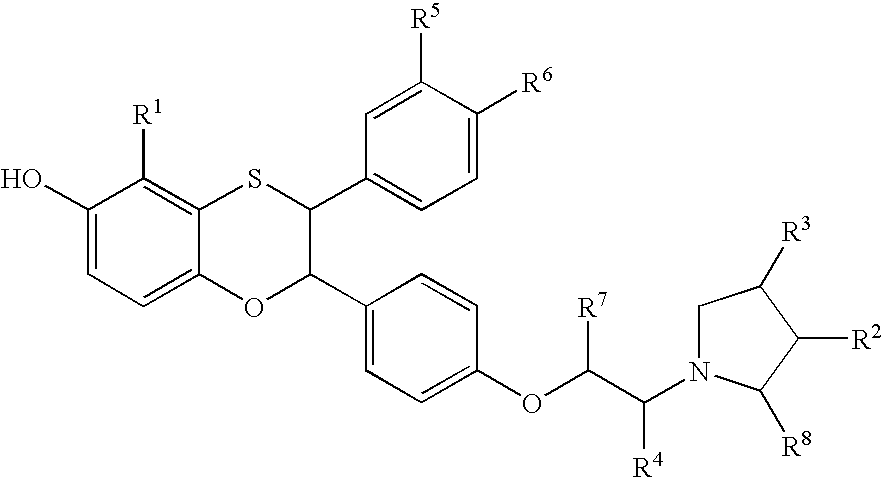Estrogen receptor modulators
a technology of estrogen receptors and receptors, applied in the field of estrogen receptor modulators, can solve the problems of limiting the use of this alternative, increasing fracture risk, and less than ideal treatment with tamoxifen
- Summary
- Abstract
- Description
- Claims
- Application Information
AI Technical Summary
Benefits of technology
Problems solved by technology
Method used
Image
Examples
example 1
Preparation of 4-benzyloxy-2-mercapto-phenol
[0225]
Step A:
[0226]To a solution of thiourea (26.66 g, 0.35 moles) in 2 N hydrochloric acid (350 mL) was added a solution of 1,4-benzoquinone (25.04 g, 0.23 moles) in acetic acid (350 mL) via a dropping funnel. The resulting amber solution was stirred at ambient temperature for 35 min., then heated to 110° C. for 3 h under nitrogen. The reaction was cooled in an ice bath at which time, a pale lavender solid precipitated out of solution. The resulting mixture was stored at 0° C. for 16 h. The precipitate was collected by vacuum filtration and redissolved in ethyl acetate. The ethyl acetate solution was washed with brine, dried over sodium sulfate, and concentrated in vacuo to give the desired product as a pale lavender solid. 1H NMR (500 MHz, CDCl3) δ (ppm): 5.05 (bs, 1H), 6.80 (dd, 1H), 6.93 (d, 1H), 7.19 (d, 1H).
Step B:
[0227]To a solution of the thiocarbonate from Step A (17.47 g, 0.10 moles) in anhydrous DMF (200 mL) at 0° C. was added c...
example 2
Preparation of 2-fluoro-3-mercapto-hydroquinone
[0229]
Step A:
[0230]A 3-neck 1-liter flask equipped with a low temperature thermometer, N2 line, and dropping funnel was charged with 1,4-dimethoxy-2-fluorobenzene (20.42 g, 131 mmol). The solid was dissolved in distilled TBF (450 mL) and cooled to an internal temperature of −74° C. A 2.5 M solution of n-BuLi in hexane (63 mL, 157 mmol) was subsequently added over 25 min. under N2 via a dropping funnel. The reaction was maintained at −75° C. for 30 min., before adding solid sulfur (5.01 g, 157 mmol) in one portion. Nitrogen sparging of the reaction mixture was begun at this time and continued throughout the reaction. The internal temperature rose to −65° C. but quickly recooled to −75° C. The reaction temperature was maintained at −75° C. for 30 min. At this time, the excess dry ice in the dry ice / acetone bath was removed and the reaction was allowed to slowly warm to −20° C. over 1.5 h. The reaction was quenched with 2 N HCl with vigoro...
example 2a
Preparation of
[0232]
Step A: To a solution of the crude fluoromercaptan (12 mmol) from Example 2 in anhydrous THF (25 mL) was added 1,1′-carbonyldiimidazole (3.9 g, 24 mmol) at ambient temperature with nitrogen sparging, followed by a catalytic amount of DMAP. The reaction was stirred for 10 min., then partitioned between ethyl acetate and ice / 2 N HCl. The organic layer was collected, washed with brine, dried over sodium sulfate, and concentrated in vacuo to give a pale yellow solid. Purification by silica gel chromatography with 15% ethyl acetate / hexane as the eluant afforded the desired product as a white solid (1.91 g, 83%). 1H 500 MHz NMR(CDCl3) ppm(δ): 7.00–7.02 (m, 2H).
Step B: To a solution of the material obtained from Step A (1.91 g, 10 mmol) in anhydrous DMF (20 mL), was added cesium carbonate (6.7 g, 21 mmol) at 0° C. under nitrogen followed by benzyl bromide (1.5 mL, 12 mmol). After 2.5 h of vigorous stirring, the reaction was filtered to remove the cesium carbonate. The f...
PUM
 Login to View More
Login to View More Abstract
Description
Claims
Application Information
 Login to View More
Login to View More - R&D
- Intellectual Property
- Life Sciences
- Materials
- Tech Scout
- Unparalleled Data Quality
- Higher Quality Content
- 60% Fewer Hallucinations
Browse by: Latest US Patents, China's latest patents, Technical Efficacy Thesaurus, Application Domain, Technology Topic, Popular Technical Reports.
© 2025 PatSnap. All rights reserved.Legal|Privacy policy|Modern Slavery Act Transparency Statement|Sitemap|About US| Contact US: help@patsnap.com



